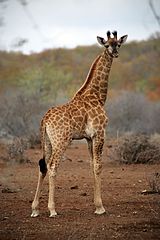South African giraffe
| South African giraffe | |
|---|---|

| |
| Male in South Africa | |
| Scientific classification | |
| Kingdom: | Animalia |
| Phylum: | Chordata |
| Class: | Mammalia |
| Order: | Artiodactyla |
| Family: | Giraffidae |
| Genus: | Giraffa |
| Species: | |
| Subspecies: | G. c. giraffa
|
| Trinomial name | |
| Giraffa camelopardalis giraffa (von Schreber, 1784)
| |

| |
| Range map in dark green | |
The South African giraffe or Cape giraffe (Giraffa camelopardalis giraffa) is a subspecies of giraffe ranging from South Africa, Namibia, Botswana, Zimbabwe, Mozambique. It has rounded or blotched spots, some with star-like extensions on a light tan background, running down to the hooves.
In 2016, the population was estimated at 31,500 individuals in the wild.
Taxonomy and evolution[]
The IUCN currently recognizes only one species of giraffe with nine subspecies.[1][2] The Cape giraffe, along with the whole species, were first known by the binomen Camelopardalis giraffa described by German naturalist Johann Christian Daniel von Schreber in his publication Die Säugethiere in Abbildungen nach der Natur mit Beschreibungen (The Mammals illustrated from Nature with descriptions) during his travel in the Cape of Good Hope in 1784. Although, it is also stated that Dutch naturalist Pieter Boddaert described and given the binomial name Giraffa giraffa whilst also identifying the nominate specimen of said species under the ternary name Giraffa camelopardalis giraffa in 1785.[3]
Following Schreber's description of the South African giraffe, several specimens were described by other naturalists and zoologists since the end of the 18th century under different scientific names, which are all considered synonyms of Giraffa camelopardalis giraffa today:
- G. giraffa capensis by Lesson, 1842
- G. giraffa australis by Rhoads, 1896
- G. giraffa wardi by Lydekker, 1904
- G. giraffa infumata by Noack, 1808
Descriptions[]

The South African giraffe has dark, somewhat rounded patches "with some fine projections" on a tawny background colour. The spots extend down the legs and get smaller. The median lump of males is less developed.[4]: 52
Distribution and habitat[]
The South African giraffe is found in northern South Africa, southern Botswana, southern Zimbabwe, and south-western Mozambique.[5] After local extinctions in various places, the South African giraffes have been reintroduced in many parts of Southern Africa, including in Eswatini. They are common in both in and outside of protected areas.[1] South African giraffes usually live in savannahs and woodlands where food plants are available. Giraffes are herbivorous animals. They feed on leaves, flowers, fruits and shoots of woody plants such as Acacia.
South African giraffes live in a fission-fusion society system based on things such as sex, age, season, and kinship.[6] This allows them to adapt better to environmental changes around them.[7]
Threats[]
The International Union for the Conservation of Nature, the body that administers the world's official endangered species list, announced in 2016 that it was moving the giraffe from a species of Least Concern to Vulnerable status in its Red List of Threatened Species report. That means the animal faces extinction in the wild in the medium-term future if nothing is done to minimize the threats to its life or habitat.
In captivity[]
South African giraffes are not very common in captivity. As of 2010, there are around 45 South African giraffes breeding in zoos.[5] At present, the South African giraffe population is estimated at 37,000 individuals, showing a marked increase of over 150% over the past three decades.[8] it has been discovered that approximately 12,000 of privately owned farms, ranches, and national parks maintain the affected giraffe populations, in which they are commonly distributed across these private areas rather than their own habitat.
Gallery[]

Three bulls, two are fighting, Kruger National Park, South Africa

Cow giraffe in Groenkloof Nature Reserve

Calf in the Kruger N. P., South Africa

Group of South African giraffe at the Jerusalem Biblical Zoo
References[]
- ^ a b c Muller, Z.; Bercovitch, F.; Brand, R.; Brown, D.; Brown, M.; Bolger, D.; Carter, K.; Deacon, F.; Doherty, J. B.; Fennessy, J.; Fennessy, S.; Hussein, A.A.; Lee, D.; Marais, A.; Strauss, M.; Tutchings, A. & Wube, T. (2016). "Giraffa camelopardalis". IUCN Red List of Threatened Species. 2016: e.T9194A136266699. doi:10.2305/IUCN.UK.2016-3.RLTS.T9194A136266699.en.
- ^ Bercovitch, Fred B.; Berry, Philip S. M.; Dagg, Anne; Deacon, Francois; Doherty, John B.; Lee, Derek E.; Mineur, Frédéric; Muller, Zoe; Ogden, Rob (2017-02-20). "How many species of giraffe are there?". Current Biology. 27 (4): R136–R137. doi:10.1016/j.cub.2016.12.039. ISSN 0960-9822. PMID 28222287.
- ^ von Schreber, A. (1784). (Camelopardalis giraffa). Southern African mammals 1758 to 1951 : a reclassification (1953): 151.
- ^ Seymour, R. (2002) The taxonomic status of the giraffe, Giraffa camelopardalis (L. 1758), PhD Thesis
- ^ a b "Giraffe – The Facts: Current giraffe status?". Giraffe Conservation Foundation. Retrieved 21 December 2010.
- ^ Deacon, F., & Bercovitch, F. B. (2018). Movement patterns and herd dynamics among south african giraffes (giraffa camelopardalis giraffa). African Journal of Ecology, 56(3), 620-628. https://doi.org/https://doi.org/10.1111/aje.12514
- ^ Wolf, T. E., Ngonga Ngomo, A. -., Bennett, N. C., Burroughs, R., & Ganswindt, A. (2018). Seasonal changes in social networks of giraffes. Journal of Zoology, 305(2), 82-87. https://doi.org/https://doi.org/10.1111/jzo.12531
- ^ "Southern Giraffe". Giraffe Conservation Foundation.
External links[]
 Media related to South African Giraffes at Wikimedia Commons
Media related to South African Giraffes at Wikimedia Commons Data related to Giraffa camelopardalis giraffa at Wikispecies
Data related to Giraffa camelopardalis giraffa at Wikispecies
- IUCN Red List vulnerable species
- Giraffes
- Mammals described in 1784
- Mammals of South Africa
- Mammals of Botswana
- Mammals of Zimbabwe
- Mammals of Mozambique
- Even-toed ungulate stubs




